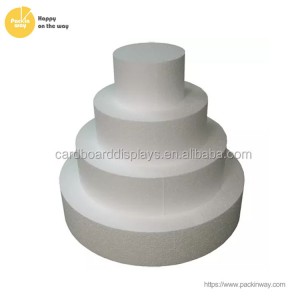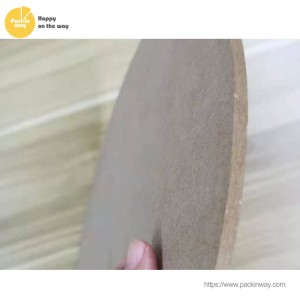Cake Board and Cake Drum is different product– What are they? How to use them?
What is a cake board?
Cake boards are thick molding materials designed to provide a base and structure to support the cake. They come in many different shapes, sizes, colors and materials, so it’s important to know which is best for your cake.Do You Really Need To Use a Cake Board?
Different types of cake boards
The term cake board is largely an umbrella term. As mentioned earlier, a cake drum is a cake board. However, they are far from the only one. While there are countless variations, here are some examples of popular cake boards.
Cake circle
These are round cake boards and usually have a thin structure. Typically these cake boards measure about an eighth of an inch.
Cake drum
As mentioned above, cake drums are an example of a particularly thick cake board. Usually they are between a quarter inch and a half inch thick.
Cake mat
These are similar to cake rings, however, they are usually thinner. As such, they are often seen as economical options.
Dessert board
These are uniquely designed cake boards for smaller desserts. As such, they are usually smaller and better suited for things like cupcakes.
Different Cake Board Materials
Cake boards also come in a variety of different materials, each of which has different uses and advantages.
Ifferent Cake Board Materials
Cardboard cake boards are some of the most common cake boards. This is because they are very cheap and disposable. The material is actually corrugated cardboard layers, with the outer layer providing stability and the inner layer providing thickness and insulation.

Foam Cake Boards
These cake boards are made of dense foam. Foam cake boards will naturally be more resistant to grease than cardboard cake boards. However, it may still be wise to cover a cake board made of foam while in use. Also, if you decide to cut the cake on a foam cake board, then you should be careful not to cut the cake board.

MDF/Masonite Cake Boards
These cake boards are made of dense foam. Foam cake boards will naturally be more resistant to grease than cardboard cake boards. However, it may still be wise to cover a cake board made of foam while in use. Also, if you decide to cut the cake on a foam cake board, then you should be careful not to cut the cake board.

MDF/Masonite Cake Board
Masonite cake boards made from MDF (medium density fiberboard) are the reusable option in the cake board world. The caveat with MDF boards, however, is that they must be covered with something like fondant or foil to protect the cake board. Because of this problem, these types of cake boards are often dedicated to structural support for multi-layer cakes such as wedding cakes.
What cake board do I need?
Different types of cake boards will work better for some types of cake projects than others.
Cake Board for Standard Cakes
For most regular cakes without layers, a standard cake ring works well to provide stability for the base of the cake. Usually these will be cardboard cake boards, although cake boards made of foam, MDF or laminated particleboard should also be easy to find.
Cake Boards for Heavier and Layered Cakes
However, for heavier cakes, you will need a cake drum. This is because the extra weight can cause thinner cake boards to either sink in the middle or possibly collapse completely. In a pinch, another option is to use two or more standard cake circles that are either taped or glued together.
Cake board for square cakes
Cake mats are usually square. Therefore, they are often the best cake board choices for square cakes. However, for heavier cakes, the rather thin nature of the cake mat can cause problems. A potential solution is to find a square cake drum, or make some thicker DIY cake boards using multiple cake mats glued together.
cake board for small cakes
For smaller desserts like cupcakes or maybe a slice of cake, a dessert board is what you want. These cake boards are much smaller than other options, making them suitable for smaller desserts.
How to Cover a Cake Board in Fudge
Covering a cake board with something like foil is a very easy process. This is because the same principles of wrapping gifts can be easily applied.
On the other hand, however, the process of covering a cake board with fondant is much more complicated. Despite this fact, I do believe the added complexity is worth it because the end result is often truly stunning.
To cover the cake board in fondant you should replicate the steps below:
1. Roll out the fondant to a size at least half an inch wider than the cake board. If using a cake drum, you may need to be a little wider. Also, a thickness of about three or four millimeters is ideal.
2. Prepare your cake board with some piping gel. To do this, brush the gel evenly, but not too thickly, on the surface of the cake board.
3. Lay the fondant as flat as possible on the cake board while making sure that the circumference hangs evenly. Then use fondant smoother to flatten it completely.
4. Smooth the rough edges of the fondant with your fingers, then carefully cut off any excess with a sharp knife.
Let it rest for two to three days so it can dry out. After that, you will be able to use the cake board with the lid as the base for the cake.
PACKINWAY has become a one-stop supplier offering full service and full range of products in baking. In PACKINWAY, you can have customized baking related products including but not limit to baking moulds, tools, deco-ration, and packaging. PACKINGWAY aim to provide service and products to who love baking, who devote into in baking industry. Fromthe moment we decide to cooperate, we start to share happiness.
Contact us for samples
Write your message here and send it to us